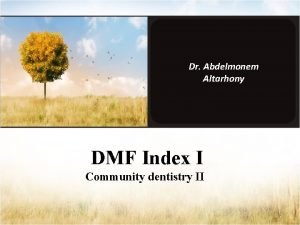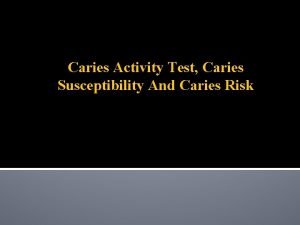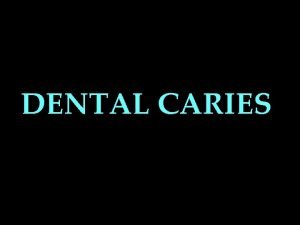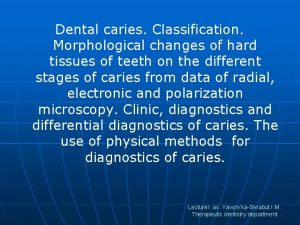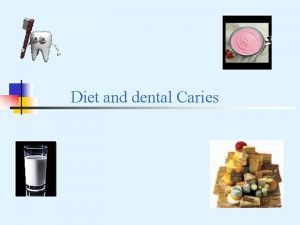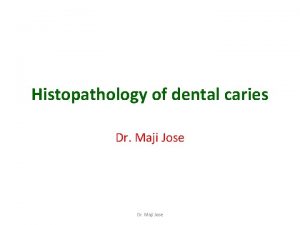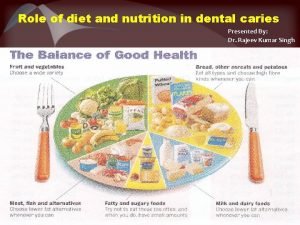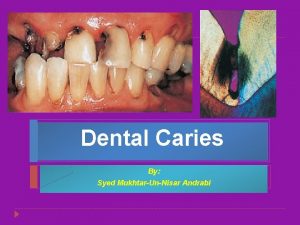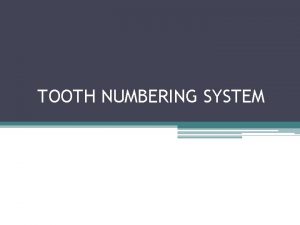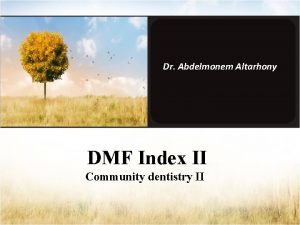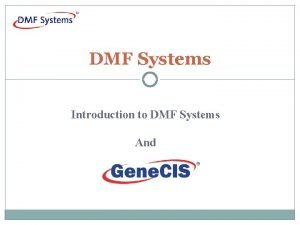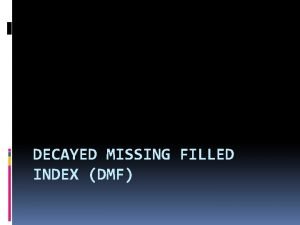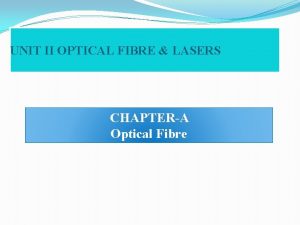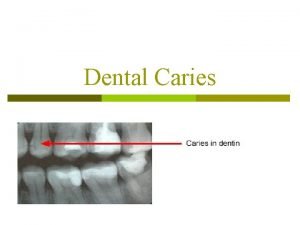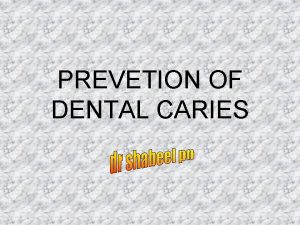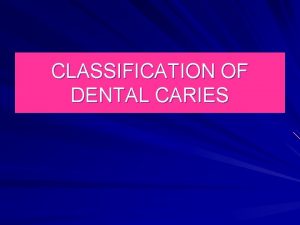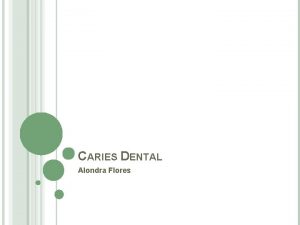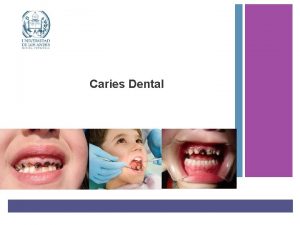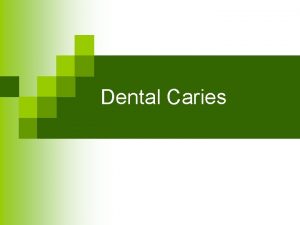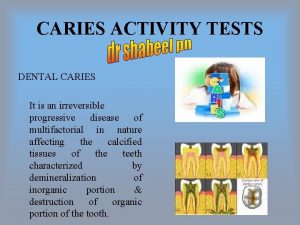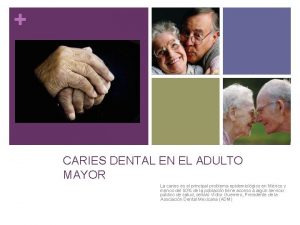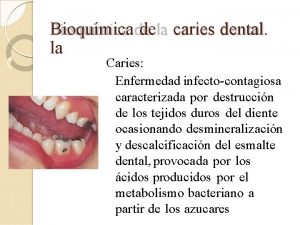1 MEASURING DENTAL CARIES Chapter 15 DMF INDEX

















- Slides: 17

1 MEASURING DENTAL CARIES Chapter 15

DMF INDEX � ID = DECAYED � M = MISSING � F = FILLED � Irreversible, simple, versatile � Provides a broad picture of caries activity in a specific population � Uppercase letters for permanent dentition � Score = 0 to 32 � Can be applied to whole teeth or surfaces (DMFS) 2 Def INDEX � d=decayed � e=extracted � f=filled � Can be applied to whole teeth or surfaces (defs) � Applies to primary or mixed dentition � Missing teeth for caries are not recorded

DIAGNOSING CORONAL CARIES 3 CLINICALLY RADIOGRAPHICALLY

4

DIAGNOSING CORONAL CARIES 5 TRUE or FALSE � Not all noncavitated lesions progress to become dentinal lesions which require restorative treatment TRUE or FALSE � Good proportion of noncavitated lesions remain static or even regress especially smooth surface lesions TRUE or FALSE � Noncavitated lesions are irreversible TRUE or FALSE � Dentinal lesions are reversible

HIDDEN CARIES 6 � A carious lesion seen in dentin on a bitewing radiograph where clinically the occlusal enamel appears sound or only minimally demineralized � There has been a rise in the number of clinically sound occlusal surfaces over the past two decades � Dentists routinely examining children who are clinically caries-free often discover a large lesion on a radiograph that was missed clinically

DENTAL CARIES INDICES 7 � DMFT count = Total DMFT divided by the population examined � deft count = Total deft divided by the number of children examined � FNM = Total filled teeth divided by total DMFT This indicates treatment received for decay (Filling Needs Met) * �

DENTAL CARIES INDICES 8 �Decayed Teeth = Total decayed teeth divided by total DMFT This indicates treatment required for unmet filling needs �Missing Teeth = Total missing teeth divided by total DMFT This indicates the number of teeth lost by decay

DENTAL CARIES INDICES 9 �Average Decayed/Missing/Filled teeth person = D/M/F teeth divided by number of people examined �UTN = Mean number decayed teeth divided by mean number decayed plus filled teeth This indicates the Unmet Treatment Needs This index can also be used to compare the treatment needs of one population with those of another Example: UTN of a community with fluorided water vs a community without fluoridated water

10 mean average median middle mode often

WHAT IS YOUR ANSWER? 11 13, 18, 13, 14, 13, 16, 14, 21, 13 WHAT IS THE MEAN FOR THE ABOVE LIST OF VALUES? 13, 13, 14, 16, 18, 21 WHAT IS THE MEDIAN FOR THE ABOVE LIST OF VALUES? 13, 13, 14, 16, 18, 21 WHAT IS THE MODE FOR THE ABOVE LIST OF VALUES? WHAT IS THE RANGE FOR THE ABOVE LIST OF VALUES?

RADIOGRAPHICALLY 12 IS IT ROOT CARIES? • Will not show a root edge image • Will show an ill-defined cupped-out or saucer-shaped radiolucency just below CEJ • Will show a diffuse, rounded, inner border IS IT CERVICAL BURNOUT? • Will show tissues at the CEJ that are thinner than enamel above it and alveolar bone below it • Will show a radiolucent wedge configuration adjacent to the CEJ • Will show radiolucent ill-defined margins

ROOT CARIES

CERVICAL BURNOUT 14 � This is a phenomenon caused by relative lower x-ray absorption on the mesial or distal aspect of teeth, between the edge of the enamel and the adjacent crest of the alveolar ridge

ROOT CARIES INDEX 15 �It evaluates the extent of root caries and client’s risk for root caries disease �It includes only those root surfaces exposed to oral environment by gingival recession �R = root surface �D = decayed root surface �F = filled root surface �N = intact, sound root surface �RCI = (R - D) + (R - F) (R-D) + (R-F) + (R-N)

ROOT CARIES INDEX 16 � It can computed for an individual, for a population at large and for specific tooth type � It is recommended that RCI be applied to both supra and sub gingival lesions, however, scores for each type of lesion are recorded separately � Example: A Root Caries Index (RCI) of 7% indicates that of all the teeth that had gingival recession, only 7% were decayed or filled on root surfaces

CARIES TREATMENT NEEDS 17 COMMUNITY (Survey) � Detects fewer carious lesions � Miss early lesions � Difficult to determine treatment need by a survey � Scores a tooth by how it appears at present time PRIVATE PRACTICE (Practitioner) � Detects more carious lesions � Can overtreat � Treatment plans for same clients vary drastically from DDS to DDS � Judge if minor lesion in primary tooth will develop into major lesion over time
 Dmf in dentistry
Dmf in dentistry Lactobacillus colony count test
Lactobacillus colony count test Difference between nursing bottle caries and rampant caries
Difference between nursing bottle caries and rampant caries Forward and backward caries definition
Forward and backward caries definition Senile caries
Senile caries Turbid dentin
Turbid dentin Finns modification of cavity preparation
Finns modification of cavity preparation Vipeholm study conclusions
Vipeholm study conclusions Zones of enamel caries
Zones of enamel caries Dental caries
Dental caries Zone of caries
Zone of caries Zsigmondy tooth numbering system
Zsigmondy tooth numbering system Dmf dentistry
Dmf dentistry Dmf systems
Dmf systems Dmft calculation example
Dmft calculation example Chinese dmf
Chinese dmf Dmf model
Dmf model Optical fibre
Optical fibre
